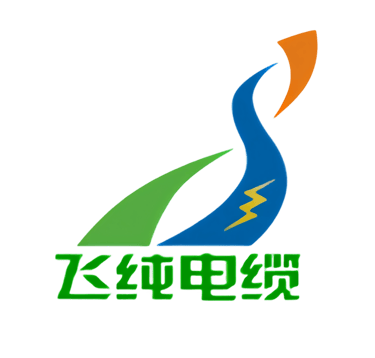📞+86 153 7530 2641 📧 hongjing.Wang@feichuncables.com
High-Flex (N)SSHOEU 3E 0.6/1 kV Mining Power Cable for Underground, Tunnel & Open-Cast Applications – DIN VDE 0250 Approved
Discover the high-flex (N)SSHOEU 3E 0.6/1 kV cable—engineered for underground mining, tunnel construction, and open-cast operations. DIN VDE 0250 approved, it is ideal as a flexible power supply cable for motors, pumps, and drilling rigs.
hongjing.Wang@Feichun
10/10/202513 min read


Introduction
The mining and construction industries demand electrical infrastructure that can withstand some of the most punishing conditions on earth. Underground mines, tunnel excavation sites, and open-cast quarries present unique challenges: constant vibration, abrasive dust, moisture ingress, mechanical impact, and the need for frequent equipment repositioning. In these environments, power cables are not merely conduits for electricity—they are critical safety components that must perform reliably under continuous stress while maintaining operational integrity.
The (N)SSHOEU 3E 0.6/1 kV cable represents a specialized solution engineered specifically for these demanding applications. This rubber-sheathed flexible power cable with copper core shield combines advanced materials science with proven construction techniques to deliver exceptional performance in underground mining applications, tunnel construction projects, and open-cast operations. Designed to meet the stringent requirements of DIN VDE 0250 for electrical installations in mining environments, this cable provides a dependable power supply to motors, distribution boards, pumps, drilling rigs, and other essential equipment.
What distinguishes this cable from standard industrial power cables is its unique construction featuring individual concentric copper screening over each insulated core, providing enhanced electromagnetic compatibility and mechanical protection. This design, combined with high-grade EPR insulation and a chlorinated polyethylene outer sheath, enables the cable to maintain electrical performance and physical integrity through countless flex cycles, exposure to oils and chemicals, temperature extremes from -25°C to +60°C in flexible operation, and immersion in water up to 2,000 meters depth.
Product Specifications
Voltage Rating and Conductor Configuration
The (N)SSHOEU 3E cable is rated for 0.6/1 kV (Um 1.2 kV), making it suitable for low-voltage power distribution systems commonly employed in mining and construction applications. The designation "0.6/1 kV" indicates a rated voltage of 600V to earth and 1000V between conductors, with a maximum system voltage of 1.2 kV. The cable is also approved for operation at 640/1140V, accommodating various regional voltage standards.
The conductor configuration follows a three-phase plus earth design, with finely stranded bare copper conductors conforming to Class 5 flexibility standards. Available cross-sections range from 3x1.5 mm² up to 3x240 mm², with corresponding earth conductors sized appropriately for each power conductor rating. The earth system employs individual concentric copper screening over each insulated core (designated as "/3E"), providing superior protective earthing compared to conventional single-earth designs.
For applications requiring additional control and monitoring capabilities, variants with integrated control cores are available (designated with "+3x1.5ST" or "+3x2.5ST"), allowing signal transmission alongside power distribution within a single cable assembly. This reduces installation complexity and improves system organization in confined mining spaces.
Insulation, Sheath Materials, and Mechanical Properties
The cable's insulation system utilizes EPR (Ethylene Propylene Rubber) with specialized compound 3GI3, providing excellent electrical properties combined with exceptional flexibility and resistance to environmental stresses. EPR insulation maintains its dielectric strength across a wide temperature range and resists degradation from moisture, oils, and chemicals commonly encountered in mining environments.
Between the insulated cores and outer sheath, a waterproof EPR inner sheath provides additional protection against moisture ingress—a critical feature for cables that may be subjected to wet conditions or even full immersion. The outer sheath comprises chlorinated polyethylene (CM/CPE) with special compound 5GM5, engineered to resist abrasion, tearing, oils, UV radiation, and ozone exposure while maintaining flexibility.
Mechanical properties are optimized for the rigors of mining service:
Permanent tensile strength: 15 N/mm² cross-sectional area
Bending radius (fixed installation): 4 times cable outer diameter
Bending radius (flexible operation): 5 times cable outer diameter
Maximum conductor temperature: 90°C continuous, 250°C short-circuit
Ambient temperature range: -40°C to +80°C for fixed installation; -25°C to +60°C for flexible operation
The cable construction achieves a balance between mechanical robustness and flexibility, with cable weights ranging from approximately 280 kg/km for the smallest configuration (3x1.5+3x1.5/3E) to 11,930 kg/km for the largest (3x240+3x120/3E). Maximum tensile strengths range from 68 N for small cables to 10,800 N for large cross-sections, accommodating the physical demands of installation and operation in mining environments.
Compliance with DIN VDE 0250 for Mining Environments
DIN VDE 0250 establishes comprehensive requirements for electrical installations in underground mining operations, addressing unique safety challenges posed by confined spaces, explosive atmospheres, and high-consequence failure modes. The (N)SSHOEU 3E cable's approval for applications according to DIN VDE 0250 confirms its suitability for the most demanding mining installations.
The cable meets flame retardance requirements, features oil resistance, ozone resistance, and UV resistance necessary for harsh mining environments. These performance characteristics ensure the cable's reliable operation across critical safety parameters including flame propagation resistance, low smoke emission, resistance to oils and chemicals, and maintained electrical integrity under mechanical stress.
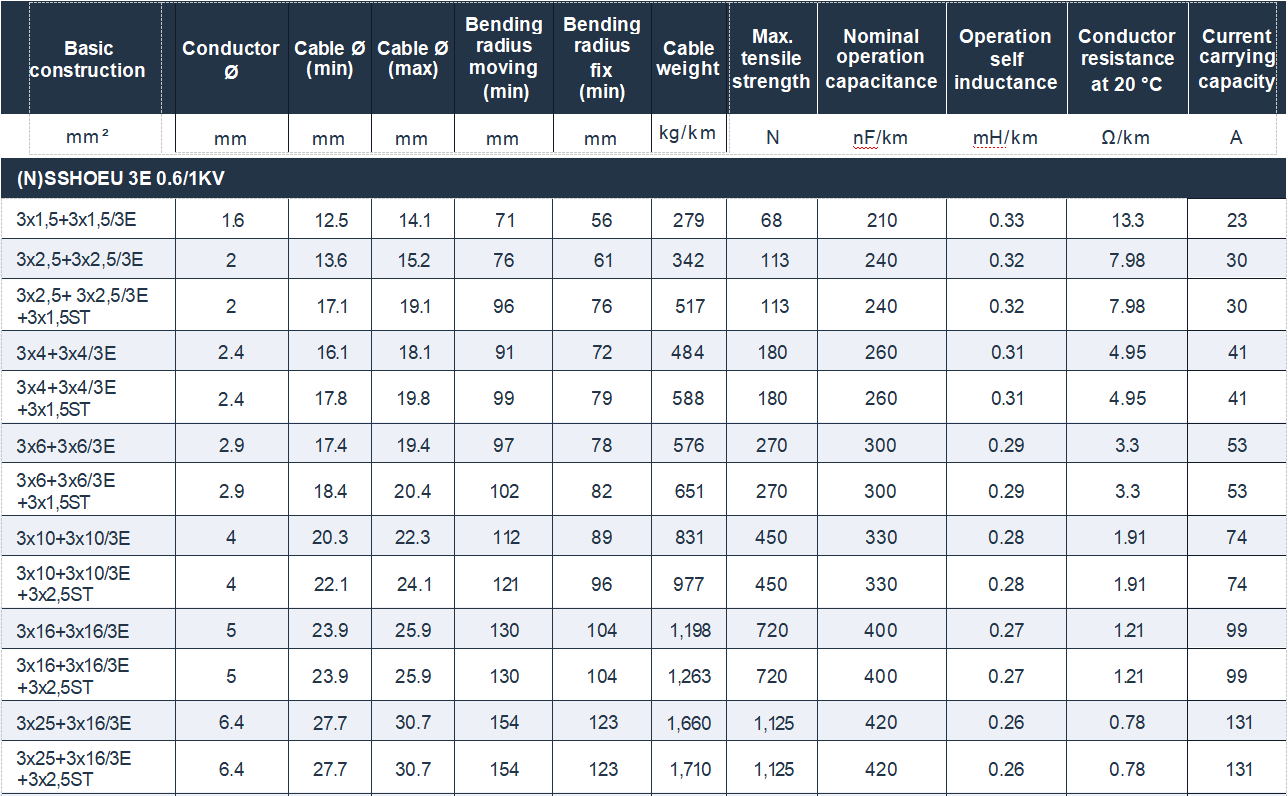

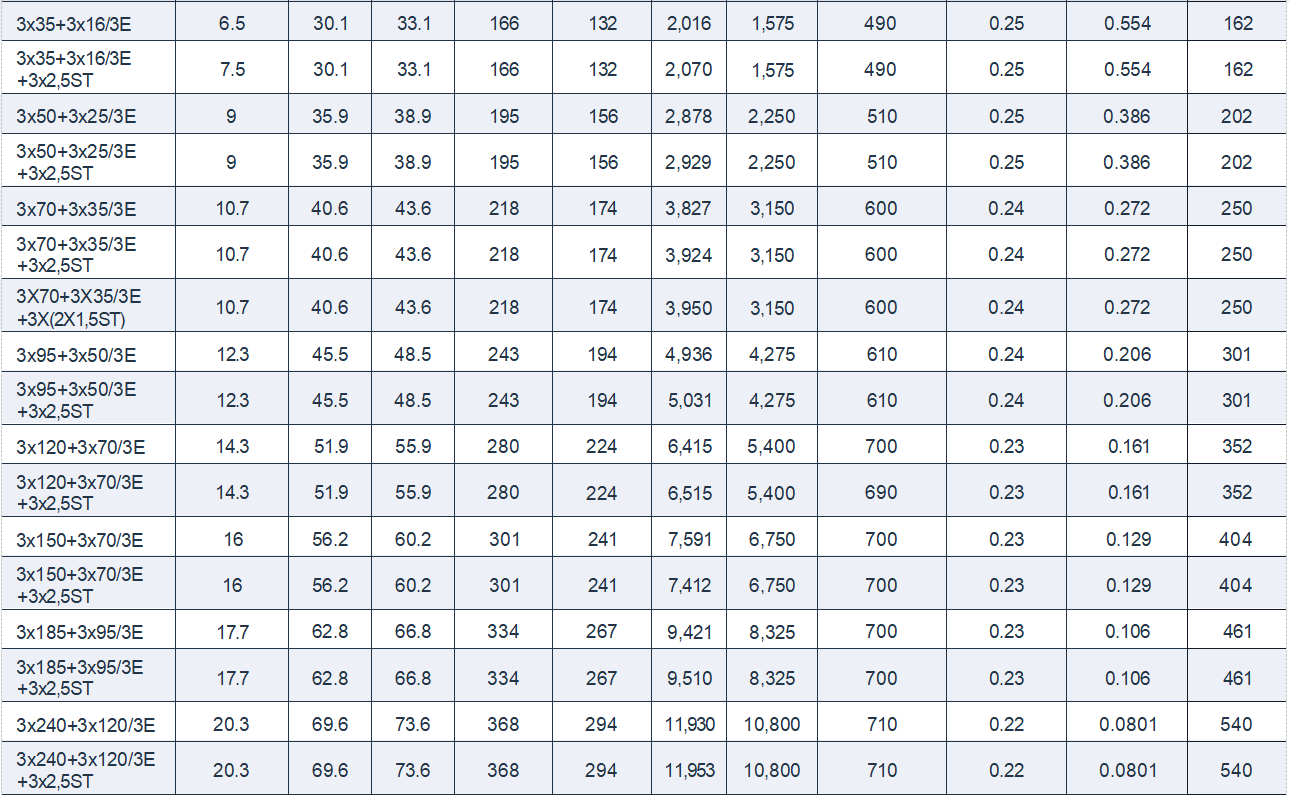

Installation & Operation
Fixed Installation Guidelines
For permanent installations in underground galleries, tunnel sections, or fixed surface locations, the (N)SSHOEU 3E cable should be installed with a minimum bending radius of 4 times the cable outer diameter. This ensures mechanical stresses remain within acceptable limits while allowing adequate flexibility for routing through cable trays, conduits, or direct burial applications.
Fixed installations benefit from the cable's excellent resistance to crushing forces and impact damage. The individual concentric screening over each core provides mechanical protection while maintaining low-impedance earth paths critical for personnel safety and proper operation of protective devices. When installing multiple cables in parallel, adequate spacing should be maintained to prevent excessive heat accumulation, with derating factors applied according to installation method and ambient temperature.
Cable supports should be positioned at regular intervals appropriate to the cable size and installation orientation. Vertical runs require more frequent support to prevent excessive tensile loading on terminations. All terminations must employ appropriate cable glands, lugs, and sealing systems compatible with the cable construction and rated for the operating voltage and environmental conditions.
Flexible Operation and Bending Radius
The cable's design prioritizes performance in flexible applications where equipment movement, cable reeling, or frequent repositioning occurs. For such dynamic installations, the minimum bending radius increases to 5 times the cable outer diameter, accommodating the additional mechanical stresses imposed by repeated flexing.
Applications involving continuous or frequent flexing—such as connections to mobile pumps, portable drilling rigs, or equipment mounted on cable trolleys—benefit from the cable's Class 5 conductor flexibility and resilient sheath materials. The construction maintains electrical and mechanical integrity through thousands of flex cycles, significantly outperforming standard industrial cables in dynamic applications.
When installing cables in festoon systems, cable booms, or similar moving applications, additional considerations apply. The cable route should minimize sharp transitions and avoid direct contact with sharp edges or abrasive surfaces. Where cables cross or contact support structures, protective measures such as roller guides or sacrificial wear sleeves should be employed to extend service life.
Safety and Handling Best Practices
Safe handling begins with proper cable storage. Cables should be stored on appropriate reels or in coils, protected from direct sunlight, moisture, and extreme temperatures. Before installation, cables should be inspected for shipping damage, with particular attention to sheath integrity and any signs of crushing or excessive bending.
During installation, pulling forces must not exceed manufacturer specifications, and pulling speeds should be controlled to prevent dynamic loading and heat buildup from friction. In underground mining applications, cables should never be dragged across rock surfaces or sharp objects—appropriate rollers, sheaves, or temporary protective coverings must be used.
Live work on these cables should only be performed by qualified personnel following appropriate lockout/tagout procedures and using voltage-rated tools and personal protective equipment. The cable's individual core screening means that earth continuity must be maintained through all connections and terminations. Regular inspection intervals should be established based on operating conditions, with more frequent inspections for cables in flexible service or harsh environments.
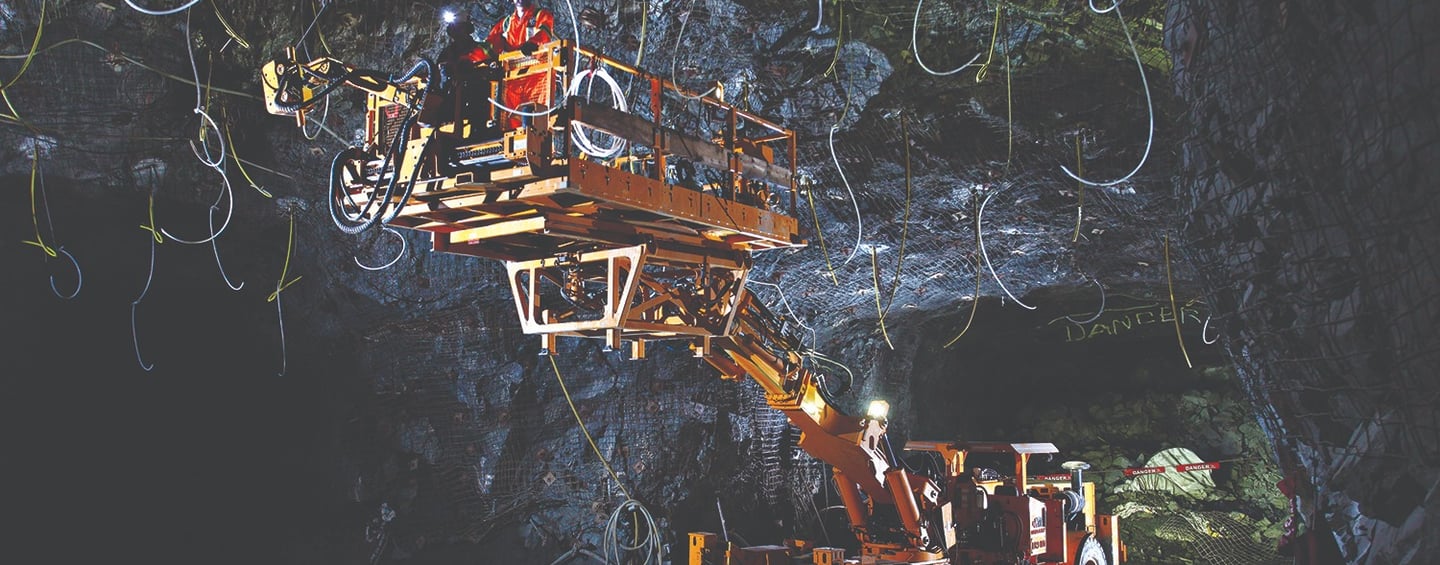

Application Scenarios
Underground Mining Power Supply to Motors and Pumps
Underground mining operations rely on a complex network of electrical equipment operating in conditions that test every aspect of cable performance. High-power conveyor motors, ventilation fans, crushing equipment, and dewatering pumps require reliable power supplies that continue functioning despite constant vibration, coal dust, moisture, and temperature fluctuations.
The (N)SSHOEU 3E cable serves as the primary power distribution solution for these applications, connecting surface or underground substations to distribution boards positioned throughout the mine workings. From these distribution points, the cable supplies individual pieces of equipment, often requiring routing through confined spaces with multiple bends and elevation changes.
Submersible pumps present particularly demanding requirements, as cables must not only survive immersion but maintain electrical integrity under hydrostatic pressure. The cable's approval for use in water depths up to 2,000 meters, combined with its waterproof inner sheath construction, makes it ideal for dewatering applications in deep mines. The excellent seawater resistance also extends the cable's utility to offshore mining operations and coastal quarries.
The individual concentric earth screening provides enhanced safety in these applications. In the event of an insulation failure on any phase conductor, the low-impedance earth path formed by the concentric copper screen ensures rapid fault current flow, enabling protective devices to operate quickly and minimize the risk of electric shock to personnel or damage to equipment.
Tunnel-Building Machinery and Drilling Rigs
Tunnel construction projects, whether for transportation infrastructure, underground storage facilities, or mining development, employ massive boring machines, drilling equipment, and material handling systems that operate continuously in confined, debris-laden environments. These machines demand flexible power cables that can withstand the constant movement, vibration, and physical abuse inherent in tunneling operations.
Tunnel boring machines (TBMs) require power cables that can be repeatedly coiled and uncoiled as the machine advances, experiencing thousands of flex cycles over the project duration. The (N)SSHOEU 3E cable's construction, with its finely stranded Class 5 conductors and resilient rubber sheaths, maintains electrical performance and mechanical integrity through these repeated stress cycles.
Drilling rigs for rock bolting, probe drilling, and exploratory work similarly benefit from the cable's flexibility and durability. These applications often involve frequent equipment repositioning, with cables dragged across rough surfaces and subjected to impact from falling rock or equipment. The abrasion-resistant outer sheath and robust construction protect against premature failure while the flame-retardant properties provide critical safety protection in the confined tunnel environment.
The cable's resistance to oils and hydraulic fluids proves essential in these applications, as leaks from drilling equipment, tunnel support systems, and mobile machinery create chemical exposure that would rapidly degrade standard cables. The chlorinated polyethylene outer sheath maintains its protective properties even after prolonged contact with these substances.
Open-Cast Mining and Quarry Equipment
Open-cast mining and quarry operations present a different set of challenges compared to underground environments. Equipment operates in exposed conditions with extreme temperature variations, intense UV radiation, and direct exposure to weather. Draglines, excavators, mobile crushers, and conveyor systems require power cables that can withstand these environmental extremes while accommodating the constant movement and repositioning characteristic of surface mining.
The (N)SSHOEU 3E cable's UV resistance and ozone resistance are critical in these applications, where cables may be exposed to direct sunlight for extended periods. The outer sheath material resists degradation from UV radiation that would cause standard cables to become brittle and crack, leading to moisture ingress and eventual failure.
Temperature cycling presents another challenge in surface operations. Cables exposed to direct sunlight may reach significantly elevated temperatures, then cool rapidly during nighttime or weather changes. The cable's thermal rating accommodates fixed installation temperatures from -40°C to +80°C, ensuring electrical performance across the full range of climatic conditions encountered in global mining operations.
Quarry applications involving stone crushing, aggregate processing, and material transport benefit from the cable's mechanical strength and abrasion resistance. The cable can be installed in cable trays exposed to flying rock fragments, routed across the ground where equipment may occasionally drive over it, or suspended from overhead structures subject to wind loading—maintaining reliable performance across all these installation methods.
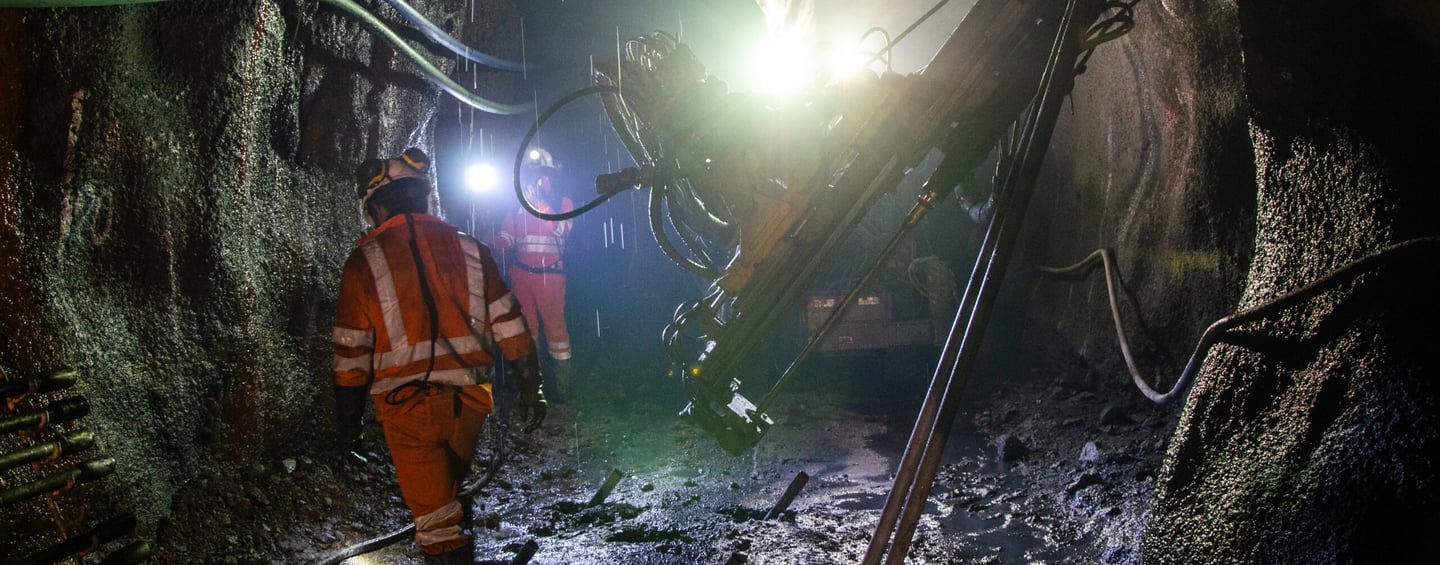

Performance Advantages
High Flexibility Under Load Cycles
The fundamental design philosophy underlying the (N)SSHOEU 3E cable prioritizes longevity in dynamic applications. Class 5 conductor stranding provides maximum flexibility, with each conductor comprising numerous fine wire strands that can slide relative to each other during bending, distributing mechanical stress across the conductor cross-section rather than concentrating it in individual wires.
The EPR insulation system enhances this flexibility with elastic properties that allow the insulation to compress and elongate during cable flexing without developing stress cracks or separating from the conductor. Unlike thermoplastic insulations that may cold-flow under mechanical stress, EPR maintains its dimensional stability while providing the resilience necessary for repeated flex cycles.
Laboratory testing confirms the cable's exceptional flex life, with samples successfully completing tens of thousands of bend cycles without electrical degradation or mechanical failure. This translates to years of reliable service in applications involving daily or even continuous cable movement—significantly longer than the service life achievable with rigid or semi-rigid cable constructions.
Resistance to Abrasion, Oil, and Moisture
The mining environment is inherently hostile to electrical equipment. Rock dust acts as an abrasive, gradually wearing through cable sheaths. Hydraulic fluid leaks, diesel spills, and lubricants create chemical exposures. Water infiltration from groundwater seepage, process water, or weather creates moisture challenges. The (N)SSHOEU 3E cable addresses each of these threats through careful material selection and construction design.
The chlorinated polyethylene outer sheath exhibits superior abrasion resistance compared to standard rubber or PVC sheaths. In standardized abrasion tests, the sheath material maintains its protective integrity even after exposure to sharp rock fragments and sustained rubbing against rough surfaces. This resistance translates directly to extended service life in applications where cables must be dragged across mine floors or repeatedly contact abrasive surfaces.
Oil resistance stems from the sheath material's chemical composition, which resists swelling and softening when exposed to petroleum products, hydraulic fluids, and industrial lubricants. This chemical stability ensures the sheath continues providing mechanical protection and moisture barriers even after prolonged exposure to these substances—a critical capability in equipment rooms, near hydraulic machinery, and in areas where fluid leaks are common.
The waterproof inner sheath provides a secondary moisture barrier protecting the insulated cores from water ingress. Even if the outer sheath sustains damage allowing moisture penetration, the inner sheath prevents water from reaching the insulation and conductors, maintaining electrical integrity. This dual-barrier approach enables continued operation even after minor mechanical damage, increasing system reliability and reducing forced outages.
Long Service Life in Harsh Environments
Total cost of ownership in mining operations depends not just on initial cable cost but on service life, reliability, and maintenance requirements. The (N)SSHOEU 3E cable's construction targets maximum service life through material quality, manufacturing precision, and design optimization for mining conditions.
Temperature cycling, one of the primary aging mechanisms for cable insulation, causes minimal degradation in EPR insulation compared to alternative materials. The rubber remains flexible across the full operating temperature range, resisting the embrittlement that affects some insulation types at low temperatures and the accelerated aging that occurs at elevated temperatures.
The flame-retardant properties of both insulation and sheath materials do not degrade significantly over time, maintaining fire safety protection throughout the cable's service life. This stable performance contrasts with some flame-retardant additives that may migrate or decompose over years of service, reducing fire performance as the cable ages.
Regular inspection and maintenance programs can identify cables requiring replacement before failures occur. Visual inspection for sheath damage, insulation resistance testing to detect moisture ingress or insulation degradation, and partial discharge testing for high-voltage stress identification enable proactive cable management. The robust construction of the (N)SSHOEU 3E cable typically reveals problems gradually through progressive deterioration rather than sudden catastrophic failure, allowing planned replacement during scheduled maintenance rather than emergency repairs.
Common Questions About Mining Cable Applications
Q: What distinguishes the (N)SSHOEU 3E cable from standard industrial flexible cables?
A: The key differentiator is the individual concentric copper screening over each insulated core (the "3E" designation), providing superior electromagnetic compatibility, enhanced mechanical protection, and improved earth fault performance compared to single-earth or unscreened designs. Additionally, the cable's approval for DIN VDE 0250 mining applications, waterproof inner sheath construction, and specialized rubber compounds optimized for mining environments distinguish it from general industrial cables.
Q: Can this cable be used in applications with variable frequency drives (VFDs)?
A: While the (N)SSHOEU 3E cable provides good electromagnetic compatibility through its individual concentric screening, applications with VFDs generating significant high-frequency harmonic currents should consider cables specifically designed for frequency converter duty, which feature additional shielding and specialized construction to minimize electromagnetic interference and reduce bearing currents in connected motors.
Q: How should cable sizing be determined for long underground cable runs?
A: Cable sizing must consider multiple factors: load current requirements, voltage drop limitations, short-circuit protection coordination, and thermal conditions. For long runs in underground mines, voltage drop often becomes the governing factor, potentially requiring conductor sizes larger than current-carrying capacity alone would dictate. Thermal considerations depend on installation method, grouping with other cables, ambient temperature, and ventilation. Detailed calculations following relevant standards should be performed, considering the specific installation conditions.
Q: What termination methods are recommended for this cable type?
A: Proper termination requires cable glands rated for the cable diameter and environmental conditions, with appropriate sealing and strain relief. The individual concentric screens must be properly terminated to maintain earth continuity, typically by connecting screen wires to the equipment earth terminal or gland earth connection. For power connections, compression or mechanical lugs suitable for Class 5 stranded conductors should be used. All terminations should be protected from moisture ingress and mechanical damage.
Q: How can cable service life be maximized in abrasive underground environments?
A: Several practices extend service life: avoid dragging cables directly on rock surfaces; use cable protection channels, trays, or suspended installations where possible; employ sacrificial wear sleeves or protective wrappings in high-abrasion areas; maintain adequate bending radius at all times; implement regular inspection programs to identify developing damage; and replace cables showing significant sheath wear before insulation becomes exposed. Proper installation practices preventing excessive mechanical stress have greater impact on service life than any material property.
Q: What inspection and testing intervals are recommended for mining power cables?
A: Inspection frequency should be based on operating conditions and criticality. For cables in fixed installations under mild conditions, annual visual inspections may suffice. Cables in flexible service, harsh environments, or critical applications warrant more frequent inspection—potentially monthly or quarterly. Electrical testing (insulation resistance, high-voltage testing, partial discharge measurement) should be performed annually or when visual inspection reveals concerns. Any cable showing mechanical damage, moisture ingress, or electrical anomalies should be investigated immediately and replaced if compromised.
Conclusion & Ordering Information
The (N)SSHOEU 3E 0.6/1 kV rubber-sheathed flexible cable represents a specialized solution engineered for the demanding requirements of mining, tunneling, and quarry operations. Its unique construction featuring individual concentric copper screening, high-grade EPR insulation, waterproof inner sheath, and abrasion-resistant chlorinated polyethylene outer sheath provides exceptional performance in applications where standard cables would fail prematurely.
The available range of conductor sizes from 1.5 mm² to 240 mm², with optional integrated control cores, accommodates applications from small pumps to high-power mining machinery. Performance advantages including superior flexibility, resistance to oils and chemicals, moisture protection to 2,000-meter depths, and proven longevity in harsh environments deliver reduced total cost of ownership through extended service life and improved reliability.
The cable's construction enables both fixed installation and dynamic applications, providing a versatile solution for the full spectrum of mining power distribution requirements. When specifying cables for underground mining, tunnel construction, or open-cast operations, the technical demands of these environments require solutions purpose-built for the application.
For detailed technical specifications, cross-sectional drawings, electrical parameters, and application-specific guidance, technical datasheets are available. Sample evaluation programs can provide physical samples for inspection and testing under site-specific conditions. Pricing information and delivery schedules can be obtained by contacting technical sales representatives with project specifications including conductor sizes required, cable lengths, delivery location, and any special requirements for termination or testing.
How to Reach Us
Get in Touch
SiteMap
Product Catalogue
Reeling Cable
Festoon Cable
Shore Power Cable
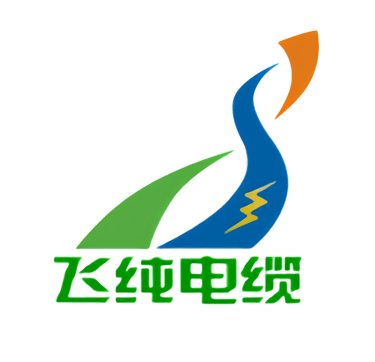



Scan to add us on WeChat
